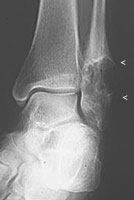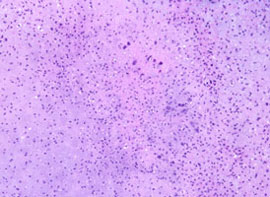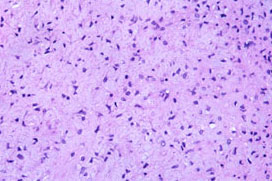|
|
|
Case #4
|
Typical Clinical Presentation:
|
A 22-year-old male presented with intermittent dull pain at the ankle of
approximately 6 months duration.
-
Pain is the usual presenting symptom in this tumor.
|
|
|
|
Characteristic Radiological Findings:
|
|
|

|
-
Plain film shows a well-defined, expansile lytic lesion, which is centered at the distal fibular
metaphysis and is bordered by a sclerotic rim.
|
|
Benign nature of the lesion is suggested by its sharp demarcation from the surrounding bone,
sclerotic rimming and lack of cortical disruption.
|
|
|
|
Pathological Findings: :
|
|
|

|
-
Biopsy specimen consisted of fragments of white-gray rubbery tissue. Low power view
shows a moderately cellular chondromyxoid tissue with the following two characteristic
features:
- Vague lobularity caused by alternating highly cellular and less cellular areas;
- Increased cellularity at the periphery of the lobules.
|
|
|

|
-
Higher magnification view of the lobule shows mildly pleomorphic, angular and stellate cells
set in bluish-pink chondromyxoid stroma. Note that the tumor lacks
true hyaline cartilage matrix seen in enchondromas and chondrosarcomas.
Another important feature is lack of mitotic activity.
|
|
|
Diagnosis: Chondromyxoid Fibroma
|
|
Salient Points::
|
-
Chondromyxoid fibroma (CMF) is a rare benign tumor with predominant occurrence in
patients younger than 40 years. The peak incidence is between ages 10 and 20. It is one
of two neoplasms of incompletely differentiated cartilage. The other neoplasm is
chondroblastoma.
-
Location. The most frequent skeletal sites are the knee area (30%), pelvis and
the small bones of the feet. In the long bone, the tumor characteristically involves
the metaphysis or metadiaphysis and is often seen in an eccentric position.
-
Secondary cystic change in the form of aneurysmal bone cyst is not unusual.
-
Differential Diagnosis of CMF includes chondroblastoma and, more importantly,
chondrosarcoma. Distinguishing features of chondroblastoma are epiphyseal location
and "chiken-wire" calcifications. The diagnostic criteria for chondrosarcoma include
hyaline cartilage matrix, tumor permeation of the surrounding bone and
mitotic activity. Keep in mind that CMFs, even those showing marked cellular pleomorphism,
have extremely low number of mitoses never exceeding 1 per 50 hpf.
-
Clinical Behavior. Recurrence rate averages 15%-20%. Large or recurrent lesions may be
locally aggressive.
Available publications for the topic:
Chondromyxoid Fibroma
|



